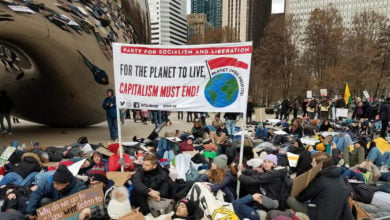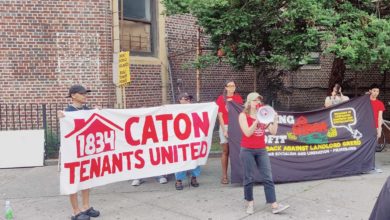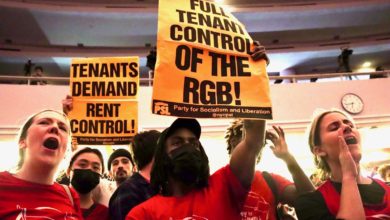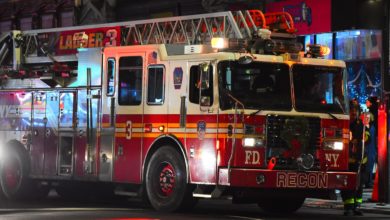Over the past year, the community of East Harlem has been in struggle against the New York City government over its plan to rezone the neighborhood. Although the City Council ultimately approved the plan on Nov. 30, the rezoning of East Harlem for luxury high rises is far from being a foregone conclusion. In a new development, the Legal Aid Society filed a lawsuit against New York City on Jan.18, challenging the rezoning plan. If successful, the suit could lead to stopping the rezoning altogether.
The lawsuit is being brought by two longtime residents of East Harlem, who share their stories of being harassed and pressured to move out by landlords after their buildings were bought by new owners. Even though the two residents lived in rent-stabilized units– or, it would be more accurate to say because they lived in rent-stabilized units– they became targets of harassment by their new landlords.
Landlords use dirty tricks to oust tenants
The landlords used dirty tricks such as illegally refusing to provide lease renewals, intimidating tenants in person, neglecting repairs, making buyout offers, and charging more rent than allowed in order to force them out. After tenants moved out of their homes, the landlords immediately pounced on the units to renovate them and set them up for higher paying tenants.
These two residents are part of the lawsuit not only because they suffered contemptible landlord harassment, but because their experiences prove a crucial point: that living in a rent-stabilized unit is still not protection from getting pushed out of your home or neighborhood. This is important because, as the suit argues, the East Harlem rezoning plan was approved based on the false assumption that people living in rent-stabilized units are not vulnerable to being pushed out and that rent-stabilized buildings are not vulnerable to being demolished and replaced by landlords.
Regulated housing-to-homelessness pipeline
If the vulnerability of rent-stabilized tenants were actually taken into account, the rezoning plan would not have been able to easily gloss over the negative impact and displacement it would cause for everyone. Considering the vulnerability of rent-stabilized tenants is especially important because of the pipeline from regulated housing to homelessness. The “largest share of families entering the city’s shelter system, 43 percent, most recently lived in buildings containing rent-regulated apartments.” That East Harlem has a particularly high concentration of rent-stabilized units shows even more that the rezoning plan totally ignored the reality of the neighborhood.
The environmental impact statement the City published on Sept. 19 actually admitted that the rezoning plan “would introduce a higher-income population to the study area in excess of 5% of the current population.” It nonetheless determined that no measures were necessary to reduce potential displacement of East Harlem residents “because the area has already experienced a readily observable trend toward increasing housing prices in the market rate units.” What this means in plain English is that the city concluded that further gentrification of East Harlem caused by its rezoning is completely acceptable because it is already gentrifying anyway.
Rubber stamp for speeding up gentrification
This callous attitude toward worsening gentrification, which is baked into the method for evaluating negative impacts of rezoning, undermines any faith in the city’s approval process for plans involving neighborhoods beyond East Harlem. In fact, since 2014, this method has “found that there is no significant adverse impact on the neighborhood’s character as the result of displacement” in “virtually every case,” essentially acting as a rubber stamp for accelerating gentrification in communities from Crown Heights (Bedford-Union Armory project) to Inwood.
The lawsuit also argues that the manual which contains this flawed method was itself “never subject to public notice and comment” and was enacted “unilaterally” by the city in violation of legal requirements. It should come as no surprise that the antidemocratic and unpopular rezoning plan was approved using standards in a document that itself was issued improperly without the legally required public input.
A spokesperson for Mayor de Blasio only had this to say about the filing of the lawsuit, which shows just how out of touch the administration is with the people of New York City: “It’s a sad day when groups try and grab headlines by trying to halt new schools, parks, anti-eviction services and thousands of affordable apartments for some of the lowest-income New Yorkers. This plan invests in the very people who call East Harlem home today.”
How city lies about “affordable” housing
To see how false this statement is, you only need to look at the numbers. According to the U.S. Census, the median household income of East Harlem residents is $30,972 and nearly 60 percent of East Harlem residents have incomes below 200 percent of the poverty level, which for a family of three would be $40,840. But under the rezoning plan, the so-called “Mandatory Inclusionary Housing” requirements would only require 10 percent to 20 percent of newly constructed housing to actually be within reach for that income range. The rest of the newly created housing would be too expensive for that roughly 60 percent of people living in East Harlem.
Under one option that developers can choose under the rezoning plan, 25 percent of newly created housing would be required to be affordable to families who earn 60 percent of the “Area Median Income.” That might sound nice until you realize that equates to a household income of $51,540 for a family of three, which is higher than the 200 percent poverty level. In short, the rezoning plan does not serve the people of East Harlem and any claim of creating affordable housing for the community is mere lip service that must be exposed and cannot be allowed to fool anyone.
Community strongly opposes rezoning for luxury housing
All throughout the approval process, residents and community groups in East Harlem spoke up and showed up to display their opposition. East Harlem Preservation, Picture the Homeless, El Barrio Unite, the Movement for Justice in El Barrio and the Justice Center en El Barrio are some of the local organizations that have been active in the fight against the rezoning plan. From making statements at public hearings to protesting and displaying thousands of petition signatures against the plan, the community has made it clear that El Barrio is not for sale.
The arguments made and facts presented by the Legal Aid Society lawsuit show that rotten rules lead to rotten outcomes that displace families from their homes and tear apart entire communities. They also reveal a biased rezoning pattern that extends beyond East Harlem and involves other neighborhoods, showing the need for communities to unite to resist gentrification and demand affordable housing together. In East Harlem, we will see continued action from residents who deserve to stay in the neighborhood that they call home.





